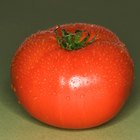
Sauerkraut contains no vinegar; instead, it gets its strong tangy aroma and flavor from the liquids produced during fermentation, a biological process that can take several days. During that time, the finely shredded cabbage actually starts to decompose, but the liquid it produces magically keeps it from going over the edge into complete spoilage. Finished sauerkraut can be stored in the refrigerator indefinitely or processed in a water bath canner for longer storage of up to a year or more. You will need the same standard canning equipment to preserve sauerkraut as if you were canning pickles, tomatoes or other high-acid foods.
Step 1
Place the canning jars in a large pan and add warm water to completely cover them. Bring the water to a boil over high heat, then reduce the heat to simmer; leave the jars in the water until you are ready to use them.
Step 2
Place new jar lids in a small saucepan and cover with water. Bring the water to a boil over high heat; reduce to simmer and keep the water hot, but not boiling.
Step 3
Place the sauerkraut in a second large pan and bring it to a boil over high heat, stirring it frequently to prevent sticking and burning. Reduce the heat when it comes to a boil and keep it hot as you prepare the jars.
Step 4
Remove the canning jars from the pan with tongs and place on a solid surface. Fill the jars with sauerkraut to about 1 inch from their tops and add enough of the brine to cover.
Step 5
Use paper towels to wipe any residue from the jar rims; remove the jar lids from the small saucepan and place them on the jars. Place bands on the jars and screw them tightly by hand.
Step 6
Set the water bath canner on the stove and lower the jars onto the rack. Fill the canner with hot water until it covers the jars by about 2 inches and bring to a full boil on high heat.
Step 7
Cover the canner and keep the water boiling. Process the quarts for 15 minutes and pints for 10 minutes. Turn off the heat and allow the water to stop boiling; remove the jars carefully and place them on kitchen towels. Allow the jars to cool completely before labeling them with the contents and date of processing. Store in a cool, dark place.
Related Articles

How to Vacuum Seal Jars

How to Cook Hominy in a Slow Cooker

How to Pickle Brine Sausage

How to Cook Lasagna Noodles so They ...

How to Can With Half-Pint Jars

How to Process & Seal Hot Sauce Bottles

How to Cook Sauerkraut and Kielbasa ...
How to Heat Process Mason Jars to Seal

How to Blanch, Peel, & Freeze Whole ...

How to Improve Jar Spaghetti Sauce With ...

How to Change My Last Name for Free

How to Can Venison Meat

How to Fold a Graco Stroller

Fresh Homemade Orange Juice Will Stay ...

How Long Does It Take to Cook Linguine?

How to Clean Your Merrell Shoes

Homemade Gold Jewelry Cleaner

How to Change the Battery in a Luminox ...

How Long Are Tamales Supposed to Cook?

How to Preserve Pimentos
References
Tips
- Sauerkraut is made by combining finely sliced cabbage with salt and allowing it to ferment, which you can do in either a 1- or 5-gallon crock. During this time, the salt extracts the natural moisture from the shredded cabbage, creating a brine, which serves as the pickling liquid. The sauerkraut is weighted down to keep it completely submerged during the process. It takes about three to four weeks at a temperature of 60 to 65 degrees Fahrenheit for sauerkraut to be fully fermented. You can refrigerate the fully fermented sauerkraut in tightly covered containers for several months.
- In addition to transferring the sauerkraut to pint or quart jars for processing in a water bath, you can freeze it for up to 12 months in pint- or quart-sized plastic containers or resealable freezer bags. Fill the containers to about 2 inches from the top, squeeze out the air if you are using resealable bags, and label them according to their contents and the date of processing.
- You can make a lot of sauerkraut, or you can make a lot. The National Center for Home Food Preservation recommends working with no more than 5 pounds of cabbage at a time when making sauerkraut, as the cabbage must be as fresh as possible before processing. The yield from 25 pounds of cabbage and 3/4-cup coarse canning salt is 9 quarts or about 18 pints of sauerkraut.
- You can make a smaller amount of sauerkraut in single quart canning jars. Fill the jars about 3/4 full with shredded cabbage and salt, and weigh it down with a smaller jar filled with stones or marbles that fits comfortably inside. Press down on the sauerkraut often, and allow it to ferment for up to 10 days at a temperature of around 75 degrees F.
- You also can freeze sauerkraut to preserve it. First boil it; then cool. Fill freezer bags to about 3 to 4 inches from their tops; squeeze out the air, seal and label the bags.
Writer Bio
Rachel Lovejoy has been writing professionally since 1990 and currently writes a weekly column entitled "From the Urban Wilderness" for the Journal Tribune in Biddeford, Maine, as well as short novellas for Amazon Kindle. Lovejoy graduated from the University of Southern Maine in 1996 with a Bachelor of Arts in English.
Photo Credits
Eising/Photodisc/Getty Images